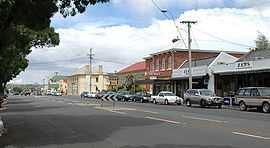Campbell Town, Tasmania
| Campbell Town Tasmania | |
|---|---|
|
Main road in centre of Campbell Town, opposite rest area | |
 Campbell Town | |
| Coordinates | 41°55′S 147°30′E / 41.917°S 147.500°ECoordinates: 41°55′S 147°30′E / 41.917°S 147.500°E |
| Population | 772 (2006 census)[1] |
| Established | 1821 |
| Postcode(s) | 7210 |
| Location | |
| LGA(s) | Northern Midlands Council |
| State electorate(s) | Lyons |
| Federal Division(s) | Lyons |
Campbell Town is a town in Tasmania, Australia, on the Midland Highway. At the 2006 census, the town had a population of 772.[1]
History
Campbell Town was originally one of the four garrison towns linking Hobart and Launceston. Campbell Town Post Office opened on 1 June 1832.[3] Today, it acts as the only major rest area on the Midland Highway, with toilets, a park, a large car park and a range of food outlets. Campbell Town is also the retail centre for much of the southern part of the Municipality Midlands area.

One of Campbell Town's features is the convict-built Red Bridge, the oldest bridge on the National Highway. It was named by Governor Macquarie after his wife, Elizabeth Campbell, as was the river passing through the town, the Elizabeth River.[4] The bridge and causeway, were built as a part of the original main road, it was to be a part of Bell's line of Road, but this road never got past Oatlands. Construction was commenced in 1836 and completed in 1838.[5] It consists of drystone abutments and timber top, although the top has been replaced, the stone abutments are original, making this a rare example of early Australian stone work.
Campbell Town is also home to The Foxhunters Return, a colonial Georgian coaching inn, which retains all its original outbuildings and continues to function as an inn for travellers along the highway. Built by convicts around 1833, with the main building constructed under the direction of stonemason Hugh Keane, Foxhunters Return is described by the National Trust as "the finest and most substantial hotel building of the late colonial period in Australia." During the construction of the Red Bridge, convicts were reputed to be housed overnight in the extensive cellars beneath Foxhunters Return, which is situated on the banks of the Elizabeth River and adjacent to the Red Bridge. These cellars featuring sandstone and convict-made red brick arches and freestone walls are now home to The Book Cellar, and so open to the public daily.
Attractions
Given the history of Campbell Town, there are an abundance of colonial buildings that have been well preserved. The town offers tourists a heritage walk, showcasing notable structures like the Red Bridge, Campbell Town Convict Brick Trail and Lake Leake. The town is also noted for the Transit of Venus, which was first observed by the US Navy in 1874. The phenomenon occurs in cycles of 120 years followed by every 12 years. The most recent sighting occurred on 8 June 2004.
Gallery
-
Red Bridge - Campbell Town, Tasmania
-

Heritage building in Campbell Town
-

Campbell Town rest area
References
- ↑ 1.0 1.1 Australian Bureau of Statistics (25 October 2007). "Campbell Town (L) (Urban Centre/Locality)". 2006 Census QuickStats. Retrieved 12 November 2010.
- ↑ 2.0 2.1 "Campbell Town". www.campbelltowntasmania.com. Retrieved 2009-05-24.
- ↑ Premier Postal History. "Post Office List". Premier Postal Auctions. Retrieved 16 June 2012.
- ↑ "Campbell Town". Walkabout Travel Guide. Retrieved 2007-03-12.
- ↑ "RED BRIDGE, CAMPBELL TOWN, TASMANIA, AUSTRALIA". CINTEC. Retrieved 2009-05-24.

